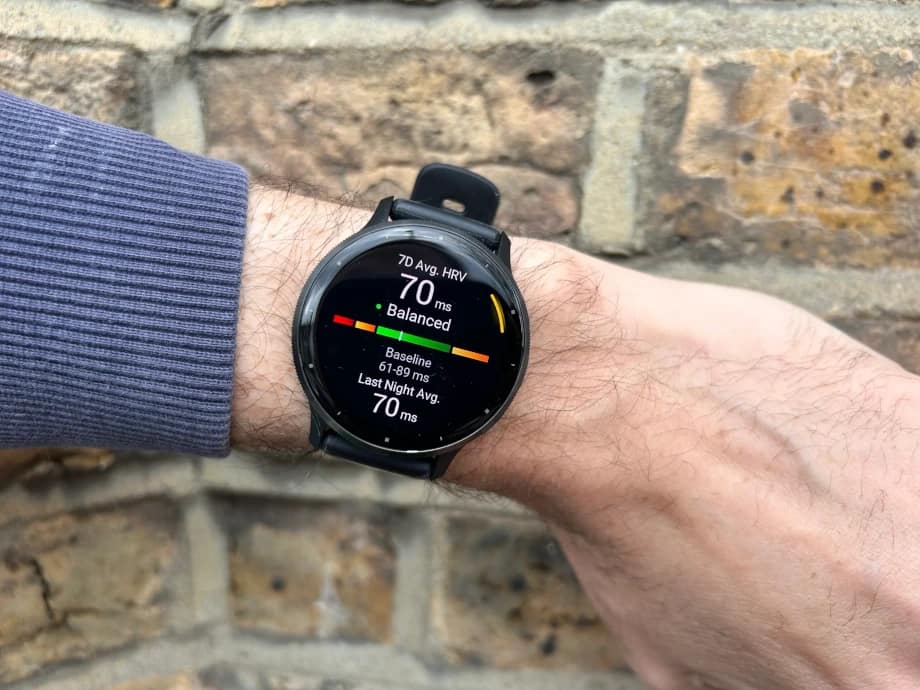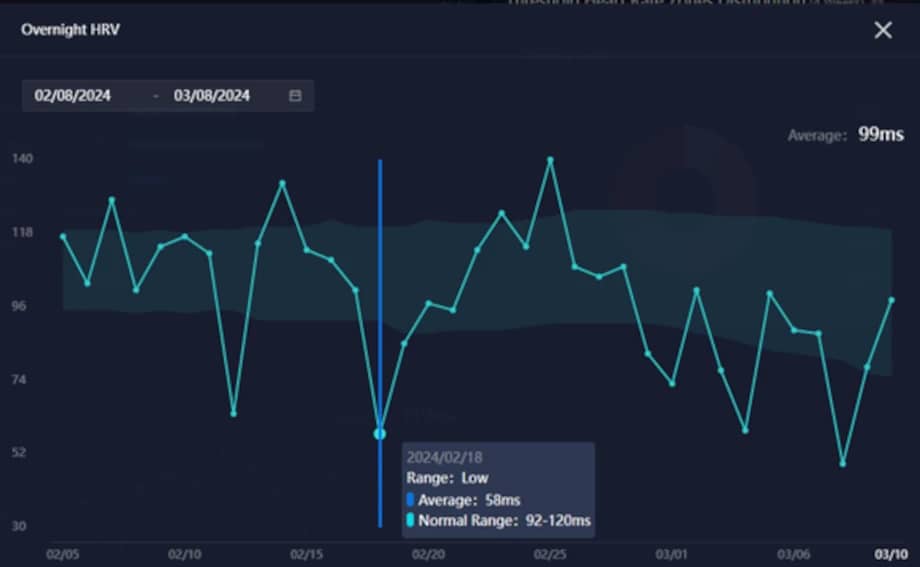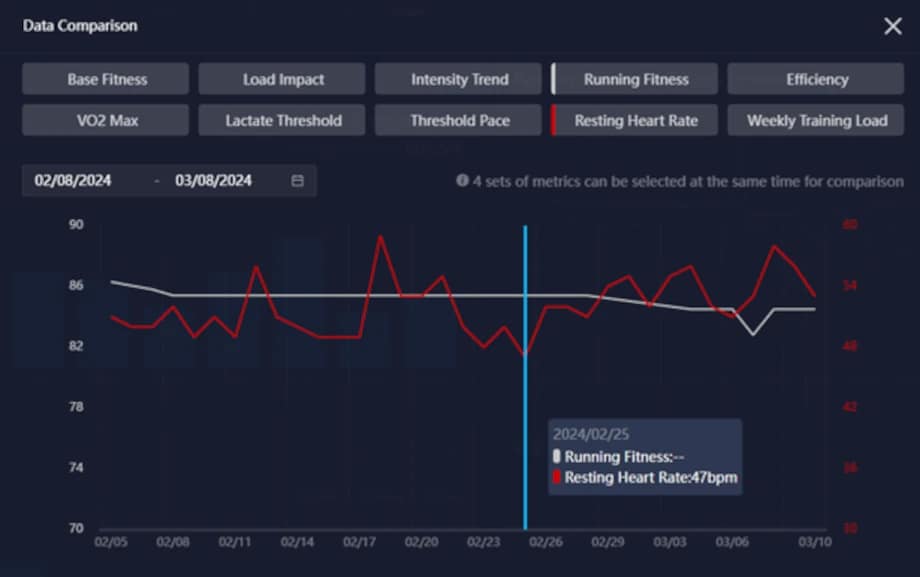
Running training involves a delicate balance. On the one hand, you want to ensure your workload rate is high, forcing your body into making the necessary adaptations to become stronger, fitter and faster. On the other, you need to give your body sufficient recovery to allow those adaptations to take place. Not allowing enough recovery is a sure fire way to get injured, get demotivated – and in serious cases, get ill.
Runners are always told “listen to your body”. I tell runners to listen to their body. But sometimes those signals are hard to interpret, particularly when it comes to the early warning signs. That’s where Heart Rate Variability – HRV – comes in.
Heart rate and Heart rate variability (HRV) explained
Most runners are pretty aware of their heart rate, both in training and at rest.
In training, heart rate is a popular – and effective – way to measure training load and to ensure that the work you are doing has its intended effect. As a running community, we tend towards using heart rate as a tool to ensure our easy runs are easy – it’s rare to see a runner do another interval because their heart rate wasn’t high enough.
At rest, our heart rate can also lead to clues regarding recovery and potential illness. If our heart rate at rest is higher than normal, that’s sending signals that something is “up”. We then spend the exact amount of time figuring out what the thing that is “up” that it takes to lower back down. But still, nice to know that something is off, nevertheless.
HRV measures the variability of your heart rate – hence the acronym. Healthy hearts don’t beat like metronomes, despite the steady counting we all do when measuring it the analogue way (with fingers… and panic that you can’t find the heartbeat). Instead, the time intervals between heartbeats can vary; and that variability is what HRV captures. Put simply:
“Heart rate is the number of heartbeats per minute. Heart rate variability (HRV) is the fluctuation in the time intervals between adjacent heartbeats” [1]
The Good (normal), the Bad (low) and the Ugly (high)
Whether your heart is more jazz or house music doesn’t matter. What matters is when you depart from your normal.
Your HRV is linked to your autonomic nervous system – i.e. your parasympathetic and sympathetic systems. The sympathetic nervous system drives your fight/flight responses when faced with a perceived threat, while your parasympathetic system is in charge of rest/digest, so when you are safe and relaxed. They both send signals to your heart, driving its fluctuations. When one or the other is off, you’ll move from your normal baseline either side. Your Garmin will show you something like this:

When the dial moves to the left, your HRV score is low and your fight/flight response has kicked in. It indicates that your body has undergone significant stress. This could be life stress – challenging period at work, problems with family etc – or it could be stress caused by training. Whatever the source, your body is perceiving a threat and is responding to help you deal with it (or run away from it).
As an ultra-runner, I shred my nervous system to pieces regularly – as you can see by my reading below the day after I ran a 100k (and as is backed up by scientific studies. [2] )

No great surprise. For interest, the previous low mark was the day I was flying to the race – so there you have it, running a 100k race is officially more stressful than flying, or at least in my world.
Runners are pretty good at understanding the fight/flight response. Well, we understand that it’s bad. Seeing that shoot low, immediately my mind was on recovery. Gentle strolls, relaxing activities, good food, and lots and lots of sleep. Which as you can see over the course of the next week really worked. It seemingly worked too well…
A week later I still felt rotten despite a high HRV. Listening to my body, I knew something was still off (and sure again a week later it plummeted right back down again – although one was the flight home). So I did some digging.
Because while there is a tonne of research and articles online about what a low HRV means, there seems to be far less on what a HIGH value means. Indeed, much of the stuff online I’ve found all imply that the higher the better. But here’s the kicker: a high HRV can be just a sign of overtraining as low. On one of the few articles I found on this, this sums it up:
Sympathetic Overtraining refers to an overactive sympathetic nervous system producing TOO MANY stress hormones. This is typically brought on by too much anaerobic work or work near lactate threshold. Parasympathetic Overtraining refers to a sympathetic nervous system which has been so taxed, which may be fatigued, and the Parasympathetic Nervous System, actually begins to gain control over the weak and fatigued SNS. [3]
So when you have a high HRV, you are experiencing an abnormally high amount of recovery in response to accumulated amounts of stress. [4] That stress can be triggered by the exact same issues as facing the sympathetic system – such as life, illness, or overtraining – but the difference is your body has had to stop prioritising fight/flight and is quite literally forcing you into relaxing and focusing on recovery. As a result, a high HRV can be much more, well ugly.
If you see the odd high HRV spike, take into account other situational and objective factors. Have you, for instance, ran 100k recently? More objectively, return to your heart rate. In training, when your parasympathetic nervous system is in overdrive, your heart rate will be lower across all effort levels [5] – your usual easy paced run of 145 might drop to 130, for instance. At rest, your heart rate will also decrease. [6] Looking at my data, sure enough on the same day my HRV skyrocketed, my resting HR nosedived.

A change in pattern here or there is nothing to be concerned about – particularly when you can link to events such as flights or races. Instead, look at the pattern of the data around the heart rate to look at the total picture. As ever though, when using these metrics, the key is always to listen to your body. And for 4 weeks post 100k my body told me to eat carbs, not run, and drink beer. Which is exactly what I did.
[1] An Overview of Heart Rate Variability Metrics and Norms – PMC (nih.gov)
[2] The effect of an ultra-endurance running race on heart rate variability – PubMed (nih.gov)
[3] Eat, Run, Sleep: Parasympathetic Overtraining and the Endurance Athlete- (troyshellhamer.blogspot.com)
[4] Is a higher HRV always ‘better’? – Elite HRV Knowledge Base
[5] Overtraining: The Elephant in the Ultrarunning Room | Uphill Athlete
[6] Can your HRV Number be too High? Here’s the Research – Myithlete


